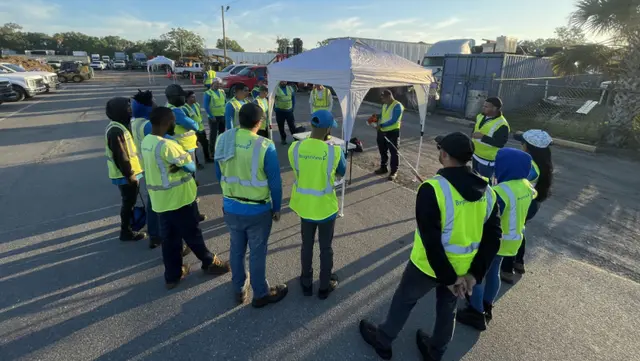
Major Hurricanes Cause Devastation, Destruction to Southern States, Puerto Rico
BrightView teams in paths of hurricanes receive support across company, begin clean up of areas
In the 166 years records have been kept, never before has the U.S. been hit by two Atlantic Category 4 hurricanes in the same season…until Hurricanes Harvey and Irma made landfall just two weeks apart.
Before affected regions could recover, a third and fourth hurricane – Jose and Maria – threatened areas still reeling and still rebuilding. All four of these storms have reached a Category 3 or higher – classifying them as major hurricanes on the Saffir-Simpson scale – and all arrived in the span of just 26 days, starting with Harvey’s landfall in Texas and ending with Maria’s strike on Puerto Rico.
“This season has been an overachiever by almost every index,” Weather Underground Meteorologist Bob Henson told the New York Times. “We’ve had more than a year’s worth of named storms when you look at the long-term average, and [we’re] just past the midpoint of the season.”
Catastrophic flooding
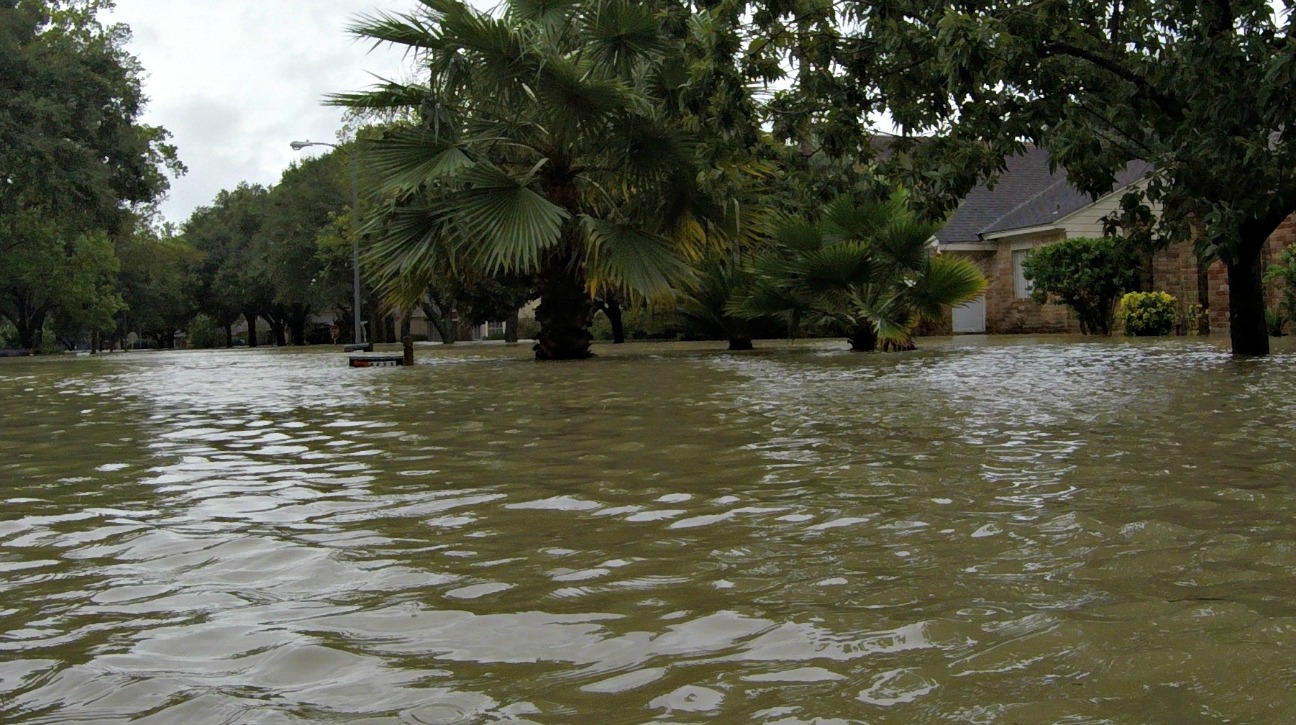
Harvey struck the Gulf Coast of Texas, making landfall as a Category 4 hurricane near Rockport late on the evening of Aug. 25, the first major hurricane to hit the state in nearly 12 years. But instead of striking the coast and moving on, the storm stalled and slowly worked its way back out to the Gulf of Mexico before turning north and making landfall a second time near Cameron, La. Over several days, the storm dropped as much as 52 inches of rain on southeast Texas and southwest Louisiana, breaking the all-time continental U.S. tropical cyclone rain records and triggering flash flooding in numerous states.
When BrightView’s Houston crew members were able to leave their homes, they didn’t find the normal downed trees and debris associated with a hurricane, but instead were met with floodwater reminiscent of a Hollywood disaster movie.
“When you think about a hurricane hitting, like back when Hurricane Ike hit, there were trees down everywhere, blown debris, and things like that and we really just didn’t have that this time,” said Chris Mink, BrightView Assistant Branch Manager in Houston. “There was just water everywhere. Some of the rivers and creeks rose 10 to 15 feet over their banks and turned streets into rivers.”
While the roads were unnavigable or closed, some BrightView team members from the Katy branch took it upon themselves to go out and pitch in anyway they could.
“Some of my crew members left their homes to conduct their own rescue mission,” said Sam Evans, Branch Manager at Katy. “They took out a blow-up, rubber raft and to help people in their community.”
Before the floodwaters had even receded, BrightView teams began visitng every client they could reach assess the damage and begin forming a game plan for clean-up.
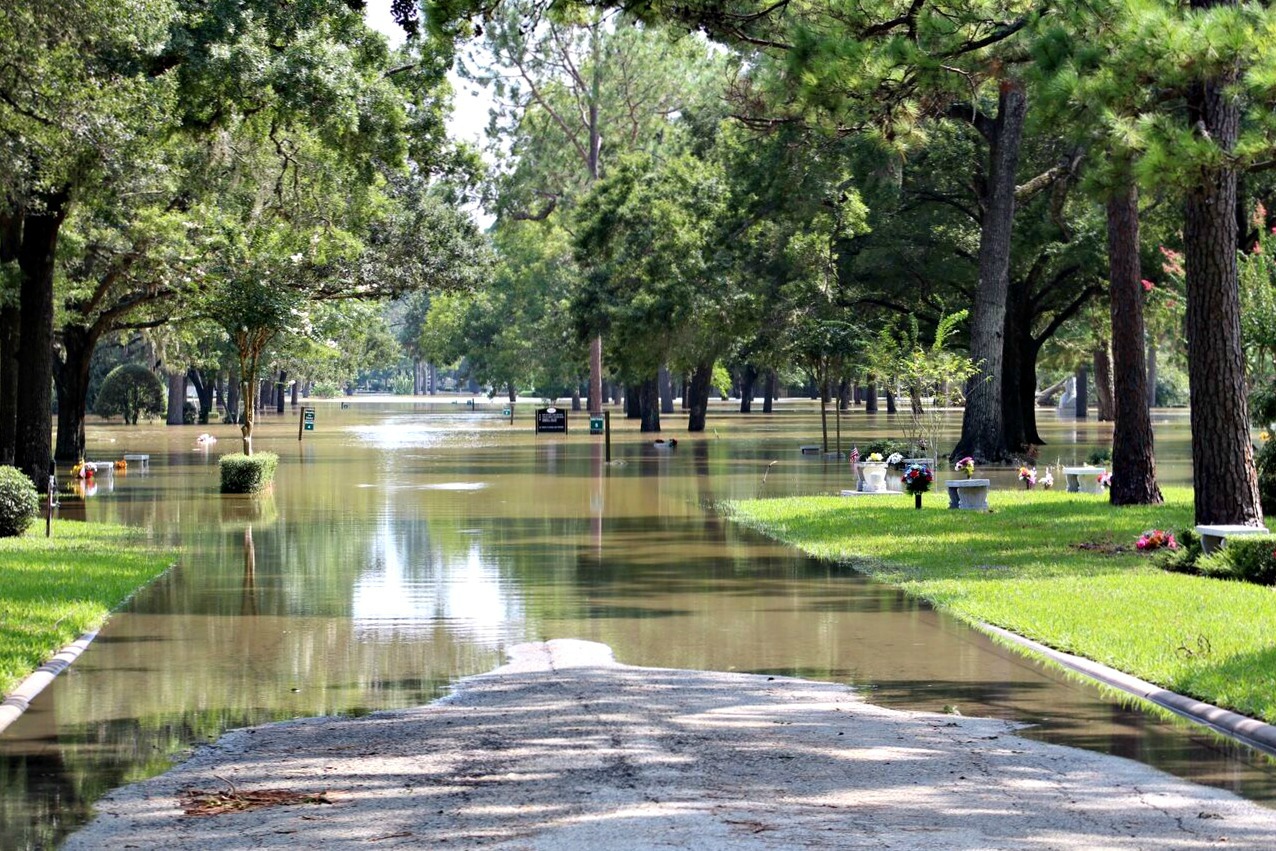
“We had some trees uprooted on some sites, but that was mainly from ground saturation and them just being old with heavy canopies,” Mink said. “Anything that the water picks up as it runs down the turf areas and landscapes, we go in and clean-up for about two or three days.”
Crews from both the Katy and Houston branches spent time at some of the larger cemeteries in the area that experienced significant flooding.
“There is a creek that runs through the middle of one of Service Corporation International’s cemeteries and floodwaters from that creek affected 75 percent of the cemetery,” Evans said. “They had a dozen roughly 80-year-old trees that were down. Crews came in from our Austin and San Antonio branches to help us out, which was extremely helpful since many of our team members were personally affected by the storm.”
Once the water began to recede in the cemeteries, BrightView crews went to work cleaning high water marks off headstones and clearing debris piled up on the graves.
Unfortunately, the kind of catastrophic flooding experienced with Harvey doesn’t just dump water and spread debris, but has a heavy impact on the plants and turf.
As the water sits on the landscapes, it not only saturates the ground, but kills the turf and plants it’s sitting on top of.
“We had one site that had 10 feet of water standing on it for almost two weeks,” Mink said. “The water has just receded there, giving us the ability to assess the damage. When you have water just standing for that long, it will kill the turf and most of the plant material by eliminating the plant’s ability to obtain oxygen and sunlight. Additionally, these waters carry silt that can be contaminated, which will also negatively affect all plant material it comes in contact with.”
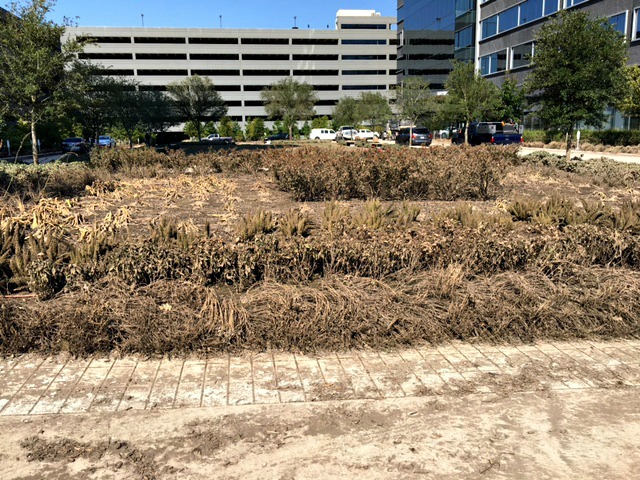
A corporate campus in the Houston area also felt the effects of Harvey’s flooding.
Ryan Powalisz, BrightView Senior Account Manager, arrived on the afternoon of Aug. 29 to find half of the roads on the campus underwater and debris littered throughout.
“We had about 20 feet of water that just rose the day before,” he said. “Storm riders on campus reported that water came within 15 feet of one of the buildings. On the east side, the water was so high that you couldn’t even see the perimeter fence.”
Joined by his Safety Manager, Powalisz spent the afternoon assessing the damage, finding debris like rocks and logs all over the roads, temporary irrigation lines both on the road and 10 feet up in trees, clogged drains, and dirt and debris covering the walkways. They also learned the client planned to have the campus reopened in two days for essential personnel.
Out of his 15-person crew, only four team members were able to make it out the next day and began the clean-up process. Five more joined in Thursday.
Over those two days, the BrightView team cleaned the drains, scraped and power washed walkways, and cleared gates and roadways that weren’t flooded to give employees the ability to safely come to work and walk to the buildings.
By Friday, Powalisz had most of his team and worked into the weekend to have the final clean-up completed for the campus to reopen to all employees on Sept. 5.
Harvey caused many shipping channels and ports in eastern Texas to close and with residents flocking to stock up on gasoline before the hurricane hit, shortages were reported throughout southeast Texas.
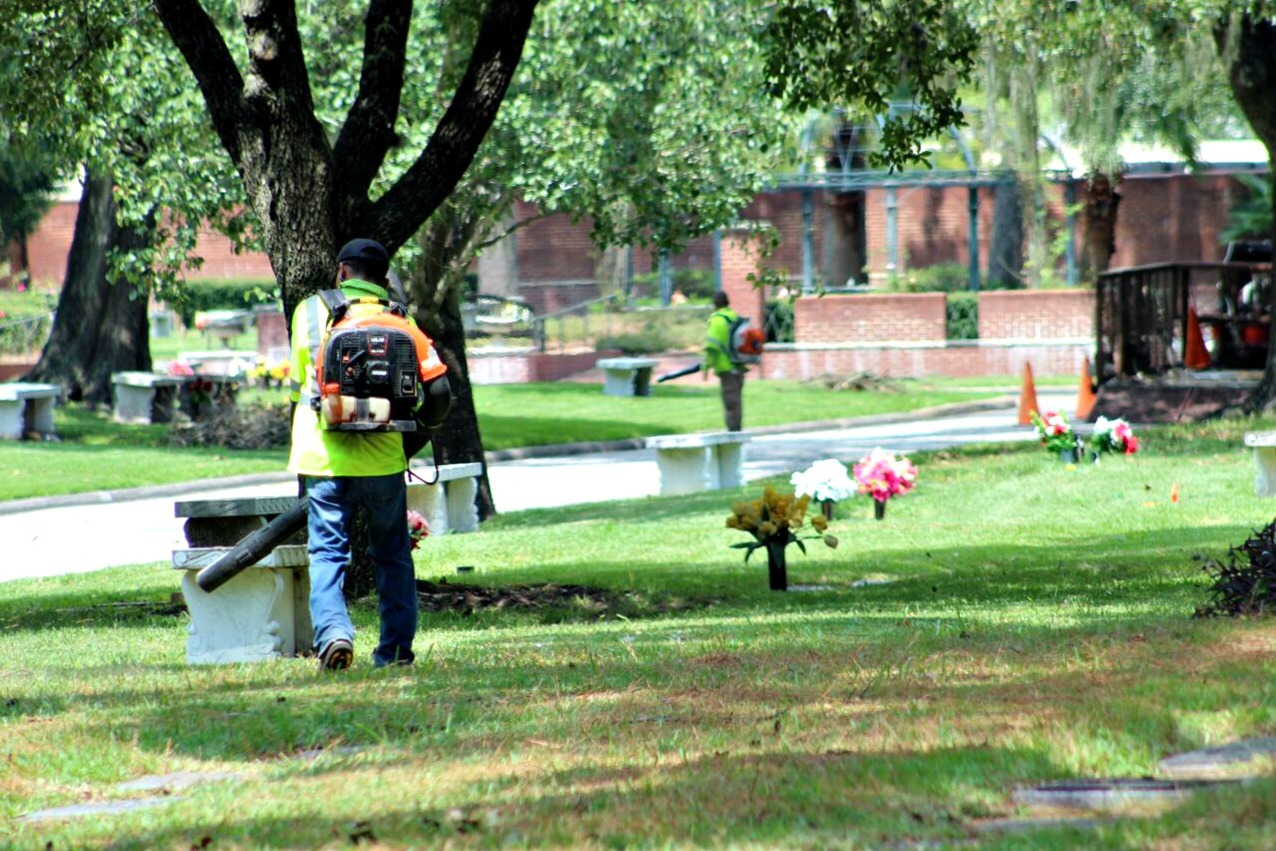
With the shortage threat looming, BrightView’s Texas Central Vice President/General Manager Greg Jacquin made sure to have a plan in place for the teams.
“Our Equipment Manager set up a program with our fuel suppliers to have the ability to fuel up our vehicles should there be a gas shortage,” Evans said. “Fortunately for us, we haven’t had to utilize that program because we have been able to fuel up at the stations, but it is a hit or miss situation. Having a plan in place and vendors that step up and commit to supply us if needed was huge. It’s the relationships our company has with our vendors and our own teams that really helped us get through this.”
While the roadways and landscapes have dried out for the most part, it’s still going to be an extensive clean-up process. Texas Governor Greg Abbott said in a statement immediately following the storm that repairs to Houston will take years and cost billions of dollars.
According to the Harris County Flood Control District, roughly 1 trillion gallons of water were dumped on the county over four days and about 70 percent of the county was flooded by at least 1 ½ feet of water. As a result, an estimated 136,000 structures were flooded.
“I can tell you that once a year, someone in the Houston area experiences some sort of flooding, but nowhere near this magnitude and how widespread this is,” Mink said. “Just from speaking with a lot of people and friends I know who had their homes flooded from this storm, most of them aren’t even in a 500-year floodplain, so they weren’t even thinking of the possibility of flooding. For homes and business, they are a long way away from being done with clean-up and repairs.”
“Monster” Hurricane
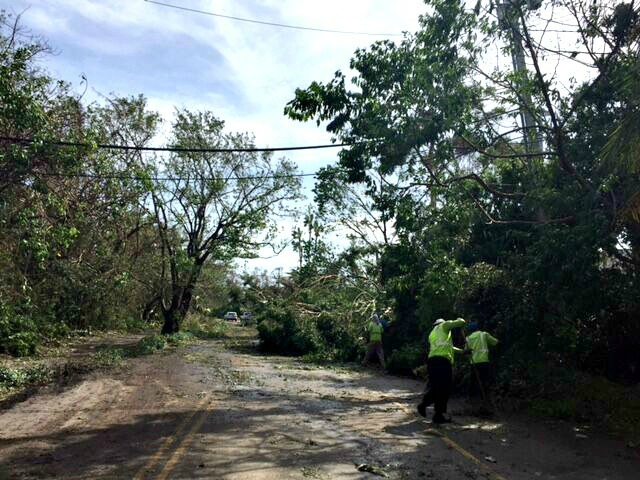
Hurricane Irma, extending 600 miles across, barreled through the Caribbean as a Category 5 storm, leaving behind unprecedented destruction, damaging 95 percent of the buildings on Barbuda and leaving the island “barely inhabitable,” according to Prime Minister Gaston Browne of Antigua.
The hurricane sustained winds of 180 mph for longer than any other storm on record in the Atlantic basin and also made it the strongest storm to ever hit the Leeward Islands.
The outer bands of the massive storm struck Puerto Rico Sept. 6, where the island’s power company warned that some areas could be without electricity for an extended amount of time.
By early afternoon on Sept. 7, almost 300,000 people had already lost power, according to the Puerto Rico Electric Power Authority.
“We were lucky that nobody on the team had significant damage to their homes, other than some minor flooding,” said Antonio Torres, BrightView Branch Manager in Puerto Rico. “However, 70 percent of this entire area was without power.”
The day after Irma, the Puerto Rico team was operating at full capacity and reported directly to client sites to begin the clean-up process.
“Our hospitality clients have been extremely grateful and have been giving our team members food and water throughout the day,” Torres said. “The effort by our team was incredible and they take pride in the fact that we had the Amgen Pharmaceuticals campus back up and running within 48 hours of the storm.”
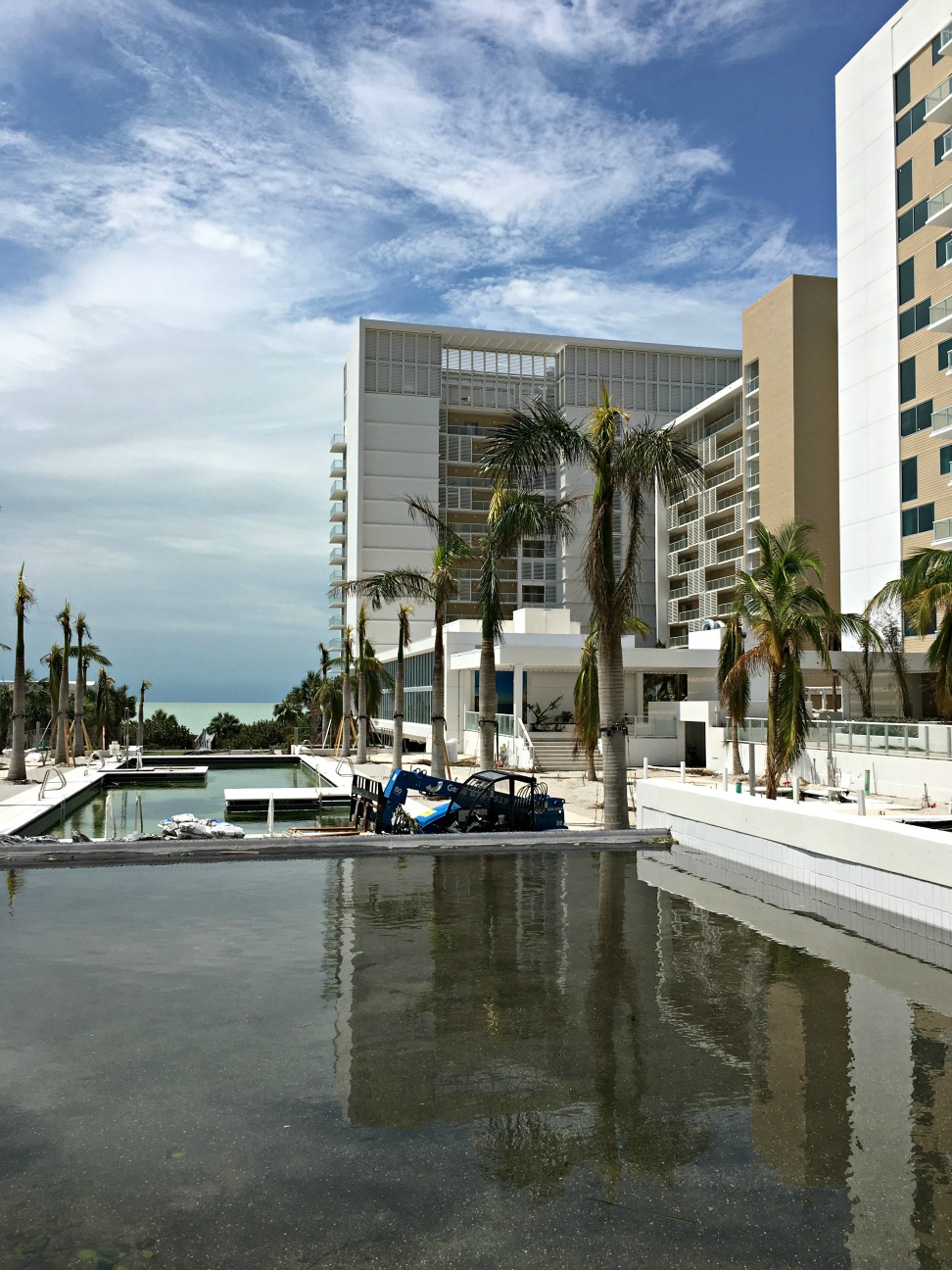
After striking Cuba, Irma swung to the north to engulf Florida and made landfall twice – once the morning of Sept. 10 in Cudjoe Key as a Category 4 and again that afternoon in Marco Island as a Category 3.
“The further south you go, the more the damage becomes worse and worse,” said Charles Gonzalez, BrightView Vice President/General Manager of the south Florida market. “Our teams are working extremely hard and many of them still don’t have power in their homes, but are out servicing our clients and team members in need. It’s not easy, but it speaks to the resilience of our teams and how dedicated they are to their work and to each other.”
The devastation in the Keys and southern part of Florida was evident, as it also was around the second landfall site of Marco Island and the close cities of Naples and Fort Myers.
“It has been encouraging to see all of our people return safely to their homes with minimal damage, but it’s also extremely sad to see the destruction to gardens and landscapes that we’ve maintained for many years,” Gonzalez said.
Though many of the landscapes were severely damaged or destroyed, one BrightView team did find a little glimmer of satisfaction among the ruins.
At a project on the southwestern tip of Marco Island, the BrightView Development team in Tampa was 85 percent complete when Irma hit. When the team visited the site after, they found that the palms installed just five months earlier, which were fully exposed to the ocean, all remained upright and standing straight.
“This was a true testament to the skill of our installation crews,” said Micah Gravel, BrightView Development Project Manager in Tampa. “Looking at the collateral damage to the area, no one would ever believe these big palms would soldier the storm. This makes me proud to be a part of this team of landscape professionals.”
Though the Orlando area missed a direct hit and therefore didn’t have quite the devastating damage as the western areas had, there were plenty of downed branches and trees pushed over.
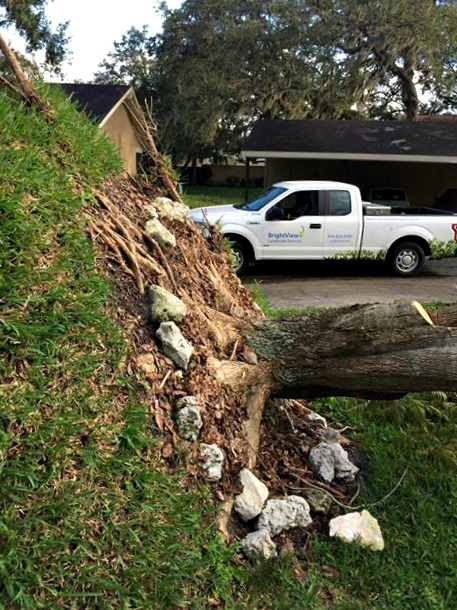
“I just spent four days without power,” said Ron Claassen, BrightView Development Branch Manager in Orlando. “It sounds pretty insignificant, but four days without power is rough. First and foremost was making sure everyone was safe and were alright in handling this disruption in our lives. The next thing was to focus on our clients.”
Unlike with many other natural disasters, people typically have time to prepare for an incoming hurricane and Claassen and his team did just that on their client sites.
“We spent some time the week before going to each client to make sure we understood what they expected after Irma and making sure we communicated what they could expect from us,” Claassen said.
Prior to Irma’s turn to the north, BrightView organized crews across many states to be on standby to lend labor and equipment to Florida when needed. Two days before the storm hit, 50 teams from New York to Georgia were awaiting the green light to head south.
Teams as far as California were even willing to make the trek.
“Teams from New Jersey just arrived here in the southern part of Florida at 3 a.m. (on Sept. 15),” Gonzalez said. “Four hours later they were at the branch, eager to help out in any way they could.”
BrightView’s team at The Villages, located roughly 45 miles northwest of Orlando, began surveying the damage to create a plan for clean-up a mere couple of hours after Irma passed. The team of 115 was joined by an additional 40 BrightView team members from Atlanta; Charlotte, N.C.; and Santa Rosa Beach, Fla, to quickly respond to such a large area.
“Our entire team stepped up to the challenge and showed why BrightView is the best to handle these situations,” said Aaron Strange, Branch Manager at The Villages. “Together, we were able to show the strength of BrightView by responding to all 100,000 homes in a 36-hour time span and all the common areas within the week.”
Puerto Rico darkened
Puerto Rico may have escaped a destructive hit from Irma, but close on her heels was Maria, which strengthened from Category 1 hurricane to a Category 5 in 15 hours.
Only four other Category 4 hurricanes in history have tracked within 75 miles of central Puerto Rico – that is, until Irma and Maria came through two weeks apart. Unlike Irma, the island wouldn’t be spared from a direct hit from Maria.
Making landfall as a Category 4 on the morning of Sept. 20, Maria became the most intense hurricane to hit Puerto Rico since the 1928 San Felipe/Lake Okeechobee hurricane with sustained winds of 155 mph.
After 14 hours of slamming the island of nearly 3.5 million people, Maria moved off the island, leaving behind collapsed rooftops, shattered windows, trees toppled, roads turned to rivers, and cement structures yanked from their foundations.
Yennifer Álvarez Jaimes, Gov. Ricardo Rosselló's press secretary, informed NBC News that power to the entire island was out following Maria’s destructive landfall.
In the wake of Maria, San Juan Mayor Carmen Yulín Cruz told MSNBC “the San Juan that we knew yesterday is no longer there.”
Officials estimate the power could be out for four to six months in Puerto Rico.
BrightView’s top priority is the safety of its team members and their families. Leaders are reaching out to the Puerto Rico team with support standing by.
BrightView lends a hand in hurricane devastation, Total Landscape Care
About BrightView:
BrightView (NYSE: BV), the nation’s largest commercial landscaper, proudly designs, creates, and maintains the best landscapes on Earth and provides the most efficient and comprehensive snow and ice removal services. With a dependable service commitment, BrightView brings brilliant landscapes to life at premier properties across the United States, including business parks and corporate offices, homeowners' associations, healthcare facilities, educational institutions, retail centers, resorts and theme parks, municipalities, golf courses, and sports venues. BrightView also serves as the Official Field Consultant to Major League Baseball. Through industry-leading best practices and sustainable solutions, BrightView is invested in taking care of our team members, engaging our clients, inspiring our communities, and preserving our planet. Visit www.BrightView.com and connect with us on X, Facebook, and LinkedIn.
For more information and/or permission to use BrightView images and assets, please send all media inquiries to [email protected]
Delivering Landscape Development Excellence
Bring big dreams to life with a simple “get it done” approach. Get your landscape installation project in the ground, on time and on budget, without the hassle.


